Exploring the differences between English and Western riding and what kind of style you’ll see judged at equestrian shows
For those who don’t know the difference between English and Western horseback riding, it’s certainly easy to be left wondering what you’re looking at and why each form of riding developed.
I grew up on a little dairy farm that my dad has witfully described as a “runaway 4-H project.” My siblings and I have shown an animal in every barn, but only one of my siblings took a liking to horses.
One day my 13-year-old sister, Olivia, came home and announced that she was the proud owner of an Arabian Standardbred named Piper, and she was going to need some help getting a stall put together. To everyone’s surprise, she wasn’t kidding; Olivia really had procured a horse.
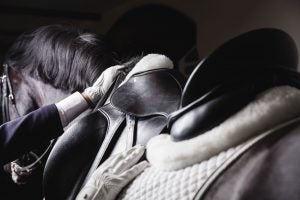
Olivia was quick to learn about proper tack, riding techniques, and how to train Piper. Until Olivia started preparing Piper for her first 4-H show, I had never thought about the different tack and riding styles.
First off, there are at least a dozen different riding styles, but they fall into either the Western or English category, so here’s an overview of what that all means and what some of the major different style are!
English Riding
English riding incorporates elements of how horses used to be trained for the military — light on their feet, quickness, and agility. English riding requires formal clothes that are sleek and form fitting, and the rider and horse always wear matching colors! English saddles are small and light, allowing the rider to have close contact with the horse. English events are beautiful to watch.
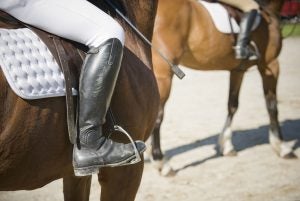
The first English style you should know is English pleasure. Pleasure riding shows that you and your horse can move like a unit, and your horse understands commands, like when you want them to pick the pace up from a trot to a jog. Pleasure riding should be easy, it is a good test of how well you and your horse get along!
Next is hunt seat, which is a course of eight jumps, and the rider and horse are given separate scores. The horse is judged on how quickly and smoothly they can jump their hurdles, and the rider is judged on their appearance and smoothness in riding.
Saddle seat is the next style, and it shows off your horse’s trotting skills. Your horse should make dramatic motions, but trot around the arena gracefully. Saddle seat is only eligible for certain horse breeds such as the American Saddlebred, the Quarter Horse, the Tennessee Walker, and a few others. If you haven’t ever seen a saddle seat show you should look it up!
Next is dressage, which is like a dance. If you’re riding dressage, you’ll have to know the exact sequence that you and your horse will have to go through as you make your way around the arena. The judges will be looking for balance, rhythm, and the obedience of the horse as the rider signals it’s time to start the next move. Dressage is beautiful to watch, and takes a lot of work to master.
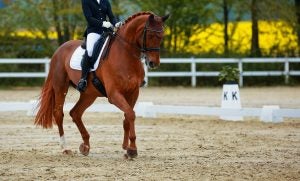
Cross country is another English event, and it shows which horses would be fit for the military! Cross country is a fast paced event in which the horse will need to clear up to 20 low level obstacles, up to 40 taller obstacles, and various other obstacles found in the field like ponds and rocks. The obstacles the horses jump aren’t always hurdles — they can also be stone walls or even tree trunks! This event shows a courageous rider and horse, and tests the swiftness of the rider and horse.
Finally there’s show jumping, which is another test of athleticism. The horse will need to clear up to 20 fragile hurdles, which have a light bar on top that will fall if the horse hits it. Show jumping is also a race, as riders will have points deducted if they go over the time it should take to complete the course.
There is one more event called eventing, which is a triathlon that begins with dressage, then cross country, and finally show jumping. These are all the different events within the English style of riding, which all show athleticism, grace, and control.
Western Riding
Western riding is based on the daily tasks of your typical ranch horse. The attire is jeans and casual or Western shirts. Western saddles are big and heavy, but they are meant to be very comfortable for the horse and rider, and they are made to distribute weight more evenly on the horse’s back. The reason for this is because cowboys have to spend long hours on horses doing tough work, so both parties need to be comfortable. Western events are fast-paced and exciting to watch.
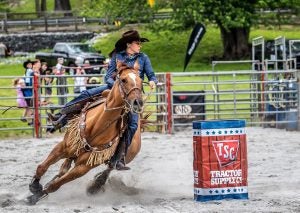
The first Western style is barrel racing, which is an event that requires the horse to make sharp and precise turns around three barrels as fast as they can without knocking the barrels over. It’s a test of agility and power.
Next you have the endurance race, which is the marathon of riding events. The endurance race is 25 miles or more, and sometimes horses are required to carry more weight than just their rider. It’s a tough race, but there really are horses on large ranches who need to carry packed equipment miles away from the farm when they push cows into new pastures.
Reining is an event similar to dressage, but the sequence of movements is different. The horse will be expected to make fast sliding stops, spin in tight circles and more. Reining is meant to show off the power of the horse, and their obedience as the rider signals them to start their next move. But what makes this event even more fun is that the horse is always moving at a lope or a gallop, so they’re moving fast!
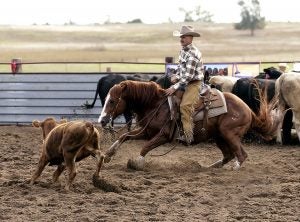
The next event is called cutting. When cutting, the horse and rider will need to cut a calf away from a herd of cows. Then to show that the horse really understands their task, the rider will loosen up on the reins and let the horse keep the calf from making its way back to the herd. It’s a tricky event that takes a lot of patience and practice on both the rider and horse’s behalf.
Finally you have Western pleasure, where the horse is expected to move a trot so steady that it looks like the horse is on cruise control. Judges want to see that the horse and rider are moving as a pair, and that the horse is comfortable toting their rider around at a slower pace that requires more muscling to keep steady.
Learning the different styles and events of horse shows isn’t too hard, and it makes watching horse shows much more enjoyable!
Elizabeth Maslyn is a born and raised dairy farmer from Upstate New York. Her passion for agriculture has driven her to share the stories of farmers with all consumers, and promote agriculture in everything she does. She works hard to increase food literacy in her community, and wants to share the stories of her local farmers.



